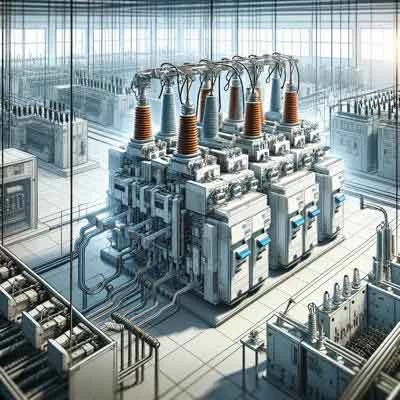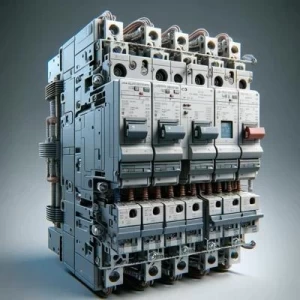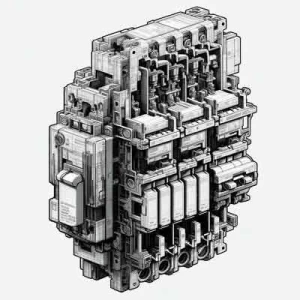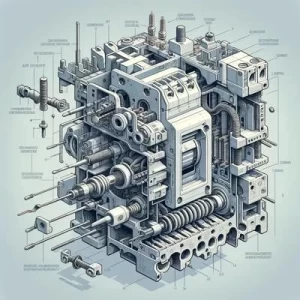Air Circuit Breaker Applications

Air Circuit Breakers (ACBs) stand as a cornerstone in the realm of electrical engineering, providing unparalleled protection and control across a broad spectrum of applications. Their primary role is to safeguard electrical circuits from overcurrents or short circuits, ensuring the stability and safety of electrical systems. This article aims to offer an in-depth exploration of the various applications of ACBs, underscoring their indispensable role in modern electrical infrastructure.
Protection of Electrical Machines
In the industrial and commercial sectors, electrical machines such as motors, transformers, and generators are vital. These machines demand continuous and reliable operation for the smooth functioning of various processes. ACBs play a crucial role in protecting these machines against electrical faults that could lead to catastrophic failures. By interrupting the power supply in the event of an overcurrent or short circuit, ACBs prevent thermal and mechanical stress on these machines, thereby prolonging their operational life and maintaining efficiency.
One of the primary applications of ACBs lies in safeguarding electrical machines like motors, transformers, and generators. These machines are the workhorses of various industries, powering countless processes and applications. However, faults or overcurrents can damage these machines, leading to costly repairs, downtime, and even safety hazards.
ACBs act as vigilant guardians, constantly monitoring the current flowing through these machines. If the current exceeds the predetermined safe limit, the ACB trips, instantaneously disconnecting the machine from the power source. This swift action minimizes damage to the machine by preventing overheating and potential arcing faults. Additionally, ACBs can be configured to provide overload protection, safeguarding against prolonged operation at excessive currents that could harm the equipment over time.
Common Protection for Multiple Electrical Machines
ACBs are uniquely capable of providing common protection for multiple electrical machines within a system. This approach simplifies the electrical protection scheme by offering a unified solution that guards against potential electrical faults across several machines. The advantage of this setup is twofold: it enhances the reliability of the electrical system and streamlines maintenance and troubleshooting procedures. By acting as a central protection point, ACBs ensure that any disruptions in operation are quickly addressed, minimizing downtime and maintaining productivity.
In situations where multiple electrical machines operate within a single system, protecting each machine individually can be cumbersome and expensive. ACBs offer a cost-effective solution for such scenarios. They can be configured to provide group protection, where a single ACB safeguards multiple connected machines. This approach simplifies the system while ensuring the safety of all connected equipment.
The ACB continuously monitors the total current flowing through the group of machines. If the combined current surpasses the set limit, the ACB trips, disconnecting the entire group from the power supply. This approach balances the need for individual protection with cost-effectiveness, making it ideal for various industrial applications.
Electricity Distribution Systems
The role of ACBs extends to electricity distribution systems, where they manage the safe distribution of electrical power across networks up to 15kV. These systems, which span from substations to end-users, are the lifelines of urban and rural infrastructure, powering homes, businesses, and critical services. ACBs ensure the integrity of these systems by providing a reliable mechanism for interrupting power in the event of an electrical fault, thereby protecting the network and ensuring the continuous delivery of electricity.
ACBs are extensively employed within electricity distribution systems, typically operating at voltages up to 15kV. These systems are responsible for transporting electrical energy from power generation plants to various consumers like industrial facilities, commercial buildings, and residential areas. Ensuring the safe and reliable operation of these distribution networks is crucial to maintain a steady flow of electricity.
ACBs contribute to grid protection by safeguarding transformers, feeder lines, and other critical components within the distribution system. They readily respond to short circuit faults, minimizing damage and preventing widespread outages. Additionally, their ability to interrupt overcurrents helps prevent line overheating and potential equipment failure, contributing to the overall stability and reliability of the power grid.
Low and High Voltage and Current Applications
The versatility of ACBs allows them to adapt to both low and high voltage and current applications, making them suitable for a wide range of settings. In low-voltage applications, ACBs protect sensitive electronic equipment and residential electrical systems, where precision and reliability are paramount. Conversely, in high-voltage industrial applications, they manage and protect circuits that power heavy machinery, where the potential for high-current faults is significant. This flexibility underscores the ACBs' ability to meet diverse electrical protection needs across various industries and applications.
One of the key strengths of ACBs lies in their versatility. They can be effectively employed in applications involving a wide range of voltage and current levels. While commonly used in low voltage systems (up to 1kV), ACBs can also be found in medium voltage applications (up to 15kV) depending on their specific design and rating.
Similarly, ACBs are adaptable to various current handling capacities. They can be customized to handle low currents powering sensitive equipment in commercial buildings or high currents feeding large industrial motors. This adaptability makes ACBs a valuable asset across diverse applications within industrial plants, commercial buildings, and various other sectors.
Industrial Plants and Commercial Buildings
Industrial plants and commercial buildings represent complex environments with extensive electrical needs, from lighting and heating to the operation of machinery and equipment. ACBs are integral to these settings, providing the necessary protection and control to ensure the seamless operation of electrical systems. They guard against electrical faults that could disrupt operations, cause equipment damage, or pose safety hazards. Moreover, in environments where electrical demands can vary significantly, ACBs offer the adaptability and reliability required to maintain operational continuity and safety.
The applications of Air Circuit Breakers are diverse and critical to the safety, efficiency, and reliability of electrical systems in various contexts. From safeguarding essential electrical machines to ensuring the smooth operation of electricity distribution networks, ACBs play an indispensable role in modern electrical infrastructure. Their ability to provide protection across a spectrum of voltage and current levels, coupled with their suitability for both industrial and commercial environments, highlights their versatility and importance. As electrical systems continue to evolve and expand, the role of ACBs in providing reliable and efficient arc interruption will remain crucial, underscoring their significance in the electrical engineering domain.
Air circuit breakers (ACBs) play a critical role in safeguarding and controlling electrical systems by offering reliable protection against short circuits and overcurrents. Their diverse applications range from protecting individual electrical machines to ensuring the stability of entire electricity distribution networks. With their adaptability to various voltage and current levels, ACBs are well-suited for a wide range of scenarios, contributing significantly to the safe, efficient, and reliable operation of electrical systems across different industries.





